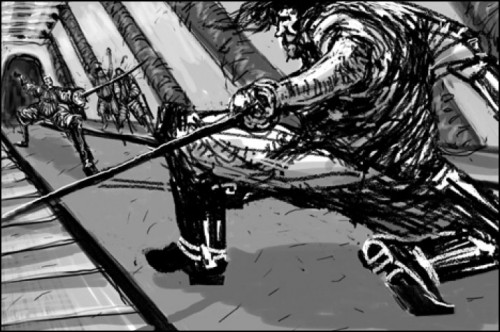The Riddle of Steeel, a fantasy roleplaying game published by the apparently-defunct Driftwood Studios, has a highly interesting combat system. Unlike many other systems, all attacks are called shots (you’re not just trying to stab somebody, you’re trying to stab him in the face or arm or somewhere), there are no hit points to speak of, attacks are actively defended against (you have no static defensive values, but you can try to block, parry, etc.)
After perusing some examples of play and looking through the rulebook, it seems to me that this system suffers from looking more convoluted on paper than it is in actual play. The following is the basic flow of how a fight goes between two parties:
a. Check for Surprise & Hesitation
Check Reflex (TN see below), failure indicates that no action can be taken until next round – proceed to step 1. Succeed and defend as normal – proceed to step b.
- TN 5: Purposely standing with no stance, inviting attack
- TN 7: Aware of opponent, but victim of a cheap shot; or hesitation
- TN 10: Unsuspecting or inattentive
- TN 13: Blindsided!
b. Declare Stance
At start of bout, or after a pause, declare stance out loud.
- Aggressive Stance: +2 CP when attacking; -2 CP when defending
- Defensive Stance: +2 CP when defending; -2 CP when attacking
- Neutral Stance: offers flexibility and no modifiers
c. Initiative – Establish Aggressor and Defender
Take a red and white die into your hands. The GM calls “throw,” and each combatant drops one of the dice on the table.
- Red: indicates aggression
- White: indicates defense
- Red/Red: a tie-breaker is required
- Both parties roll Reflex against their own ATN, apply Weapon Length penalties as normal.
- In the case of a tie, compare actual Reflex scores. Thrusts provide a +1 Reflex modifier over swings and bashes.
- If this is still a tie then the blows are simultaneous!
- White/White: The combatants circle each other, repeat the initiative process, return to start of step a.
1. Start of the Combat Round – Blood Loss Check
Successfully roll EN/BL or lose one point of HT.
- HT 1: all dice pools are halved
- HT 0: character unconscious and dying
2. Call out the Number of the Round – Fatigue
- -1 CP per 2xEN rounds of fighting. This number is further reduced by the total CP penalty for armor, shield, and encumbrance.
3. Dice Pool Refresh
- All dice pools fills or refreshes, remember to deduct spillover Shock, unless Pain is greater. Pain is deducted from all dice pools.
4. First Half of the Exchange of Blows
- Aggressor declares attack: state maneuver, CP spent, and target zone; 1-7 for swings, 8-14 for thrusts. Remember Stance (1st blow only) and Reach modifiers.
- Defender declares defense or attack: state maneuver, including CP.
- Weapon Reach: -1 CP per step to attack an opponent with longer reach, until the shorter weapon makes a damaging strike. When the longer weapon is in too close, the penalty applies to both defense and offense, until a damaging blow is scored.
5. Resolve Damage and/or Determine New Attitude
- (MOS + DR) – (Opponent’s TO + AV) = Wound Level
- If the attacker’s MOS >=0 he stays the aggressor, keeping initiative
- If the defender’s MOS 1+ he becomes the aggressor
- Shock is immediately subtracted from all dice pools, active first then reserve, any spillover applies in step 3.
6. Second Half of the Exchange of Blows
See step 4. The roles may have reversed since the first exchange
7. Resolve Damage and/or Determine New Attitude
See step 5.
8. Repeat Until a Winner is Determined
Repeat steps 1 through 7 until the combat is over – one way or another.
*whew*. Take a quick look at the target zones and damage tables (separate for slashing, bludgeoning, and piercing) and this all looks like a bit of a brain-full. But a duel between two characters in this system will frequently be resolved after only two or three rounds, with a total of maybe six throws of the dice. By the end of the first round or halfway through the second, it is often abundantly clear who has the upper hand, and one or two more exchanges seals the deal.
*summary lifted from erdtman.com/story-games/
**some excellent examples of folks muddling through a few matches can be found archived at suptg
